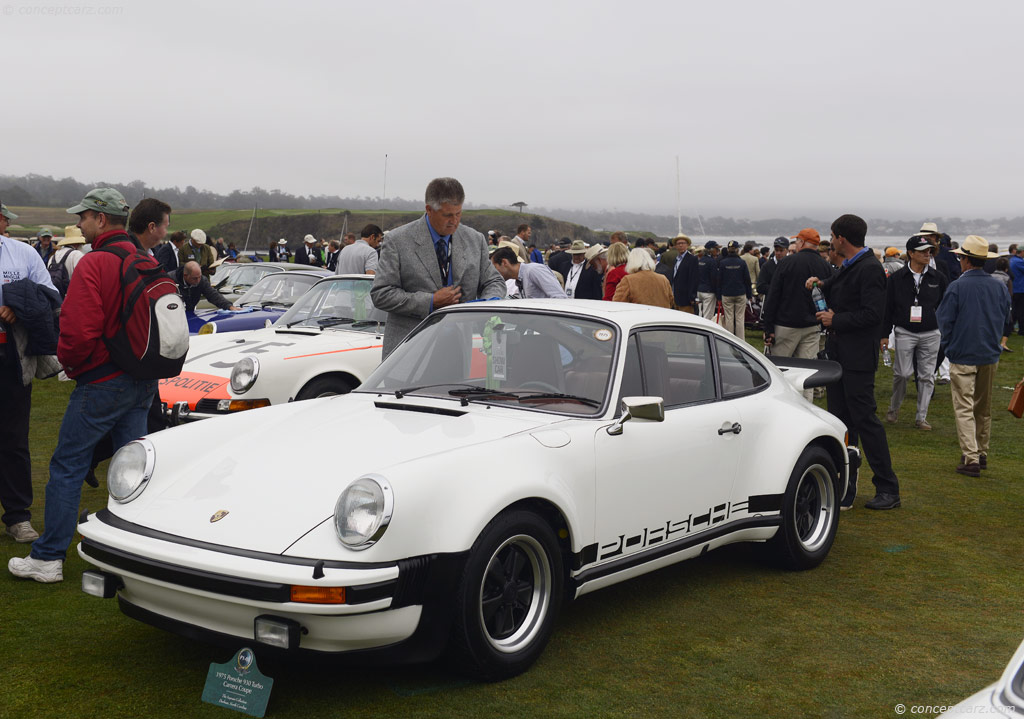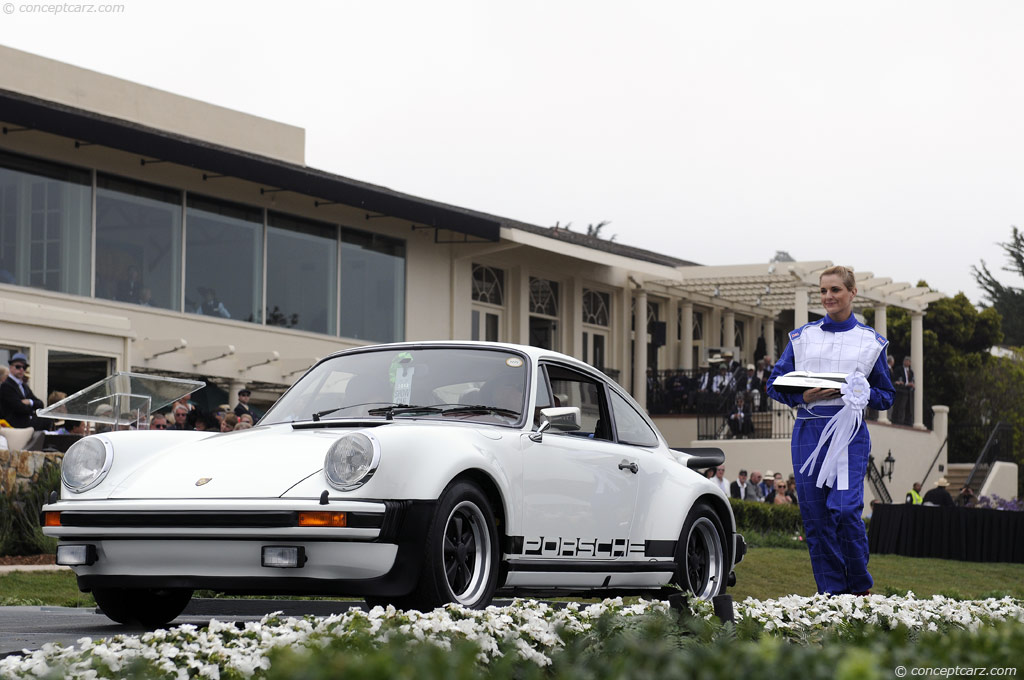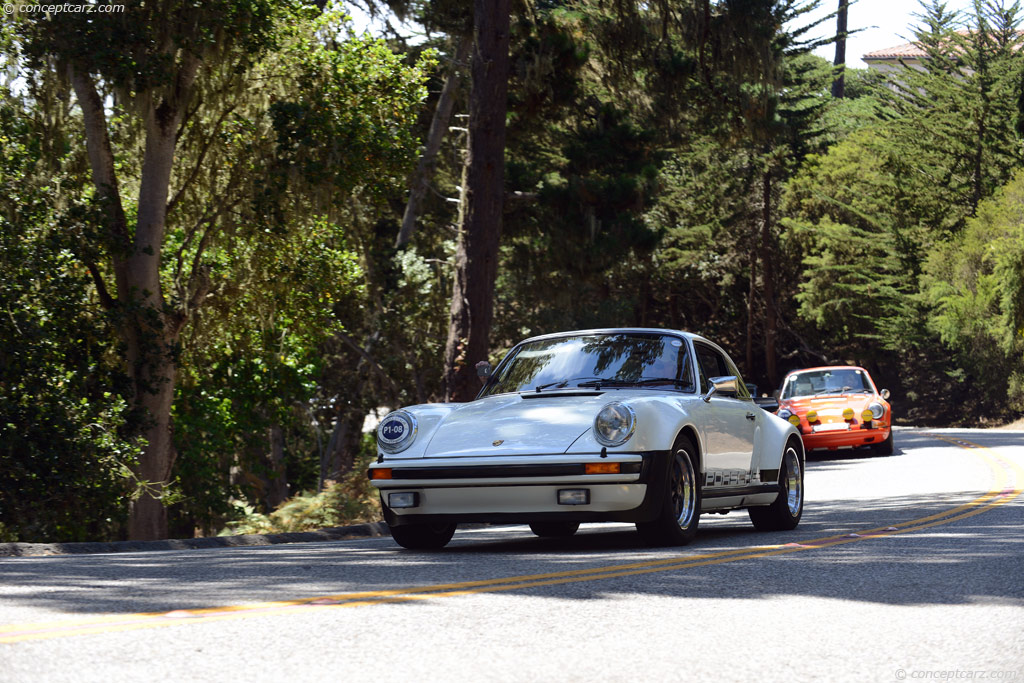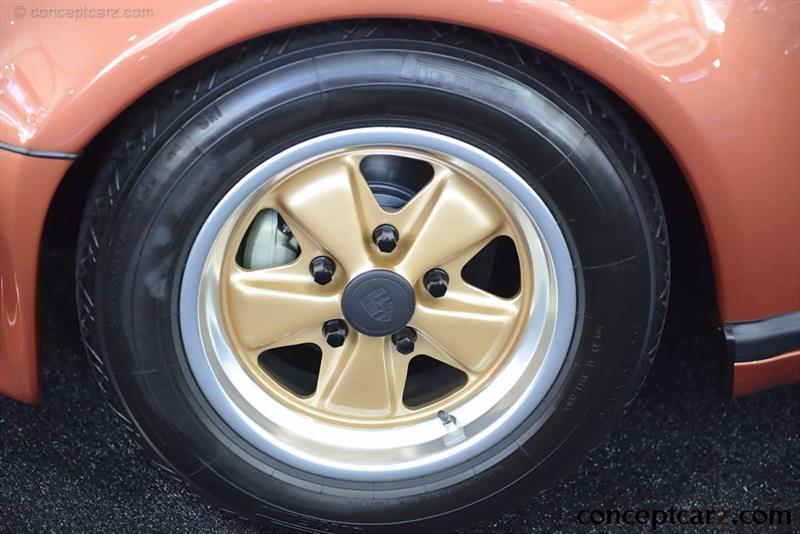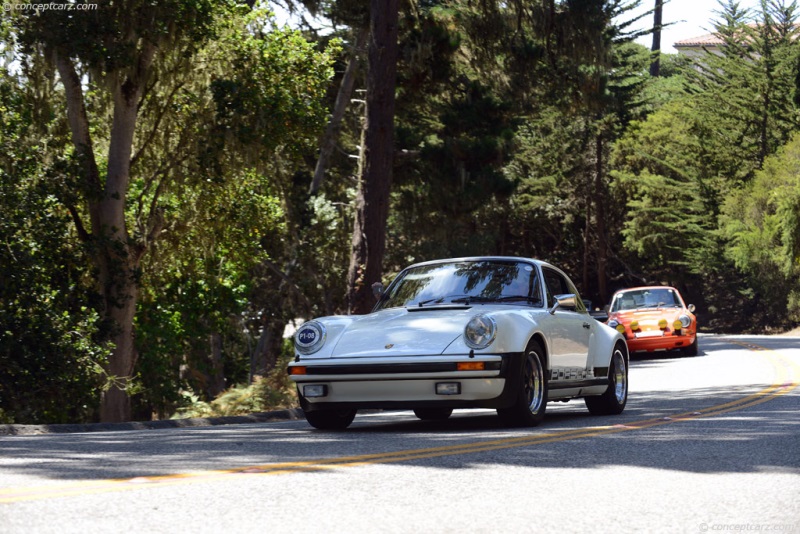The glorious whirlwind of performance vehicles of the 1960s were quickly extinguished in the 1970s by stricter safety and emission regulations. The cravings of the performance-starved world were laid to rest when Porsche introduced their turbocharged 911. Internally dubbed the Type 930, it featured a three-liter air-cooled six-cylinder engine backed by a KKK turbocharger. With a maximum pressure of .8 Bar, or about 11.5 psi, the engine developed an impressive 260 brake horsepower at 5,500 rpm and 253 foot-pounds of torque at 4,000 rpm.The exterior amplified its sporty persona, with muscular bodywork, flared front fenders and rear quarter-panels, and 15-inch diameter Fuchs forged aluminum road wheels, seven inches wide in front, and eight inches in the rear. The dramatic look continued to the rear, where a 'whale-tail' spoiler was added to provide additional down-force and to provide cooling to the engine compartment by way of a separate intake grille. A deep chin spoiler was added below the nose to balance the handling. Zero-to-sixty mph was accomplished in about six seconds flat, and maximum speed approached 160 mph.The Porsche 930 Turbo benefitted from the factory's racing program, particularly from the experience gained during the 1972 and 1973 Can-Am racing series. Its development was spurred by Group 4 homologation rules which required 400 road cars to be built. Introduced at the Paris Motor Show in 1974, production began in April of 1975 and the original 3.0-liter version would continue through 1977 with 2,819 examples built. For 1978, Porsche enlarged the engine's bore by 2mm resulting in a total displacement of 3,299cc, and added an air-to-air intercooler which cooled the pressurized air charge, boosting output to 296 horsepower at 5,500 RPM and torque to 304 lb-ft at 4,000 RPM. Exterior modifications included a re-profiled rear 'whale tail' spoiler to accommodate the intercooler. The suspension gained new anti-roll bars, larger diameter rear torsion bars, and stiffer shock absorbers. The brakes were upgraded to help cope with the increased output of the engine. In 1980, Porsche withdrew the 930 from the Japan and United States markets due to strict emissions regulations. They would return to those markets by the 1986 model year and given an emission-controlled engine producing 282 horsepower at 5,500 RPM and 278 lb/ft of torque at 4,000 RPM. Along with the emissions-compliant engine, Porsche introduced cabriolet and Targa variants.For 1983, a performance option (in Europe) for the engine boosted output to 325 horsepower at 5,750 RPM and 319 lb/ft of torque at 4,000 RPM. This option was called Werksleistungssteigerung (WLS, 'Works Performance Increase') and included a remodeled front spoiler, an additional oil-cooler, and a quad-pipe exhaust system. Most examples with this add-on option received ventilation holes in the rear fenders and modified rockers.
Production of the 930 ended after the 1989 model year when its 'G-Series' platform was replaced by the 964. The 1989 models were the only 930s fitted with the Getrag G50 five-speed manual transmission. The Type 930 did not have a direct replacement, but a turbocharged variant of the 964 did arrive several years later, in 1991, with a modified version of the same 3.3-liter flat-six engine and a five-speed transmission.
by Daniel Vaughan | Apr 2017
Production of the 930 ended after the 1989 model year when its 'G-Series' platform was replaced by the 964. The 1989 models were the only 930s fitted with the Getrag G50 five-speed manual transmission. The Type 930 did not have a direct replacement, but a turbocharged variant of the 964 did arrive several years later, in 1991, with a modified version of the same 3.3-liter flat-six engine and a five-speed transmission.
by Daniel Vaughan | Apr 2017
Related Reading : Porsche 911 History
The legendary Porsche 911 is the longest production run sports car of all time. It was conceived as a successor for the highly successful Porsche 356 and from the start had high aspirations for success. Ferry Porsches son, Ferdinand Alexander Porsche, designed the 911. When it went into production it was labeled the 901 but Peugeot had claims to the name, so to avoid infringing on their naming scheme,....
Continue Reading >>
Continue Reading >>
Related Reading : Porsche 911 History
Who could predict that the 911 would be Porsches saving grace and surpass the 356 in sales, longevity Quickly establishing itself as an icon of 60s cool, the iconic 911 only became more popular as the years went on. The flagship of the current lineup of Porsche, the 911 (pronounced Nine Eleven) or Neunelfer is a two-door grand tourer with a very distinctive design. The 911 is one of the oldest....
Continue Reading >>
Continue Reading >>
Related Reading : Porsche 911 Turbo - Type 930 History
It has been proven throughout time on many occasions that racing improves the breed. For Porsche, this is no exception. During the late 1960s, they fitted their racing cars with turbochargers which were met with positive results. This led to outfitting their road-going cars with this performance-enhancing feature. The initial intent of the turbocharged street 911 cars was to comply with homologation....
Continue Reading >>
Continue Reading >>
Related Reading : Porsche 911 Turbo - Type 930 History
The name 930 was an internal designation for a turbo 911 built from 76-93. From 1979 through 1985, the 930 was not sold in the United States. The Type 930 Coupe had been intended to satisfy racing homologation requirements that stated 500 examples were required to be built in order to race. Porsche began with the 911 and added flared fenders to protect the wider wheels and tires. A rear spoiler was....
Continue Reading >>
Continue Reading >>
Similar Automakers
1975 Porsche 911 Turbo Vehicle Profiles
Recent Vehicle Additions
Performance and Specification Comparison
911 Turbo - Type 930 Specification Comparison by Year
Year
Production
Wheelbase
Engine
Prices
Related Automotive News

Aston Martin V8 Vantage V550 30 years on: a modern classic
2023 marks 30 years of the Vantage V550 – a true modern classic
Fewer than 240 examples built between 1993 and 1999
Presented at launch as the fastest and most powerful production Aston Martin yet
5.3-litre V8 twin supercharged 22 coupe with 5...

TIMEWARP 4,400-MILE 1985 PORSCHE 911 CARRERA 3.2 COUPE GOES ON SALE AT HEXAGON
Hexagon is proud to offer for sale one of the lowest mileage Porsche 911 Carrera 3.2 Coupes in the world
Incredible 1985 Garnet Red example has been perfectly preserved since birth and has just 4,429 miles on the clock
Carrera 3.2 was the last-of-...
MODEL YEAR 2015: NEW GOLF FAMILY, REDESIGNED JETTA, AND NEW TDI® CLEAN DIESEL ENGINE HEAD THE CHANGES
In a busy year, Volkswagen will also add a new Golf SportWagen, an all-new Golf R, a redesigned Touareg SUV, and the companys first U.S.-market EV, the e-Golf
All-new Golf is bigger, lighter, and more fuel-efficient than the previous model,...

MAZDA MX-5 MIATA CELEBRATES 25 YEARS OF EXHILARATION
Celebrate the Worlds Best-Selling Two-Seat Roadster on Twitter with hashtag #MX5Turns25
CHICAGO, Feb. 7, 2014 - On February 9, 1989, the world was introduced to the all-new Mazda MX-5 Miata at the Chicago Auto Show. A few months later, it w...

The Mercedes Benz S Class: automobile comfort of the highest standard
S Class the epitome of automobile comfort
Every generation of vehicles provides ground-breaking solutions to the expectations of customers with regard to comfort
The history of the Mercedes Benz S Class shows that automobile comfort is far more...
